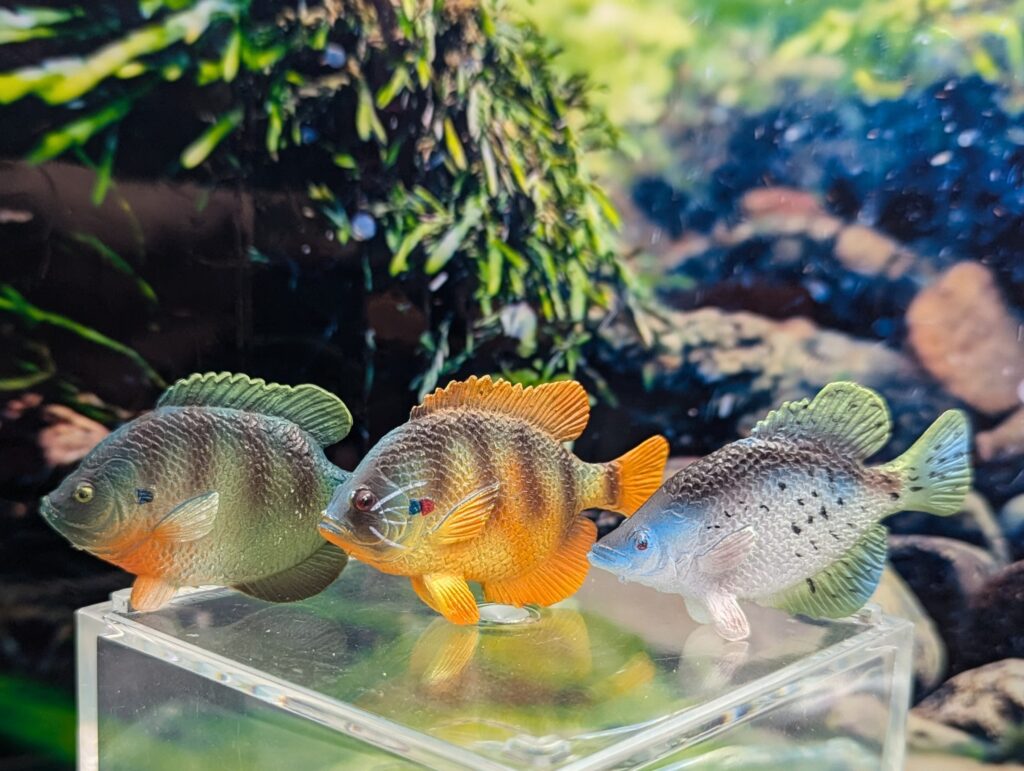
And here we have the final trio of the original 3″ fish produced by Replica Toy fish, the second half from the ‘pond fish’ set. Similar to my look at the two halves of the American Angler set (here and here), the first Pond Fish set featured a range of taxonomic groups, and this second half will be all from a single family–Centrarchidae, the basses and sunfish. And yes, the first half of this set also featured a species from the same family (the largemouth bass) but I wanted to balance the posts! Plus, these 3 fish share a lot of broad similarities, and fall within a loose group referred to as ‘pan fish’, popular angling targets that generally don’t outgrow a frying pan! They may also be, subjectively, the three most colourful figures in the set.
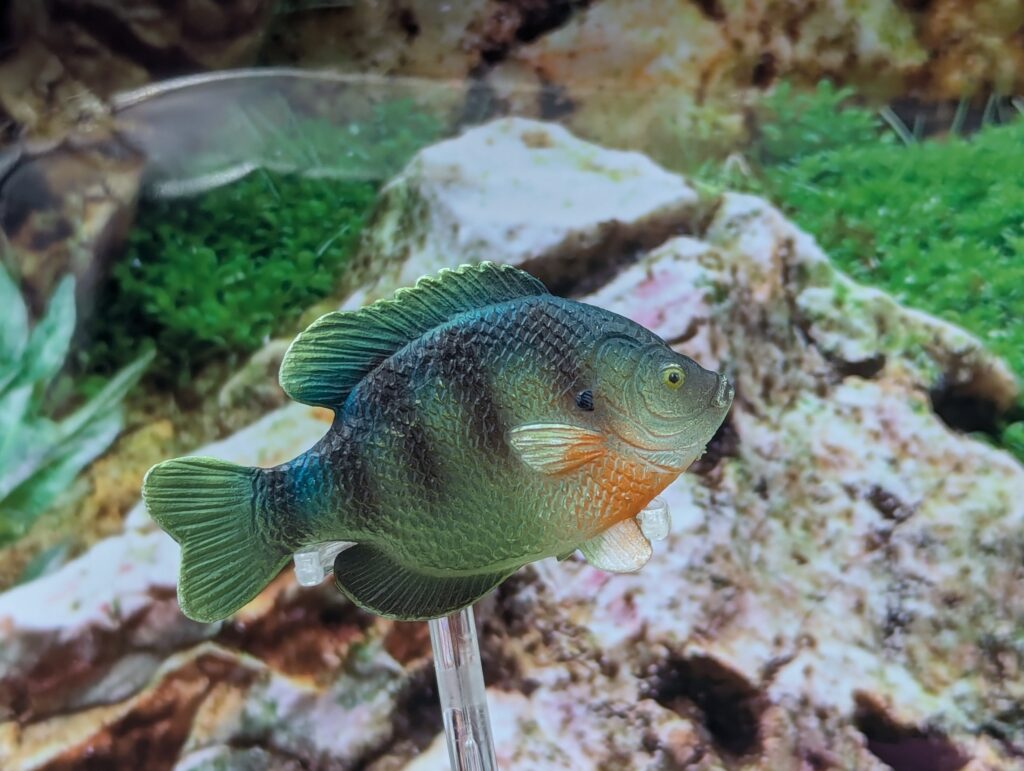
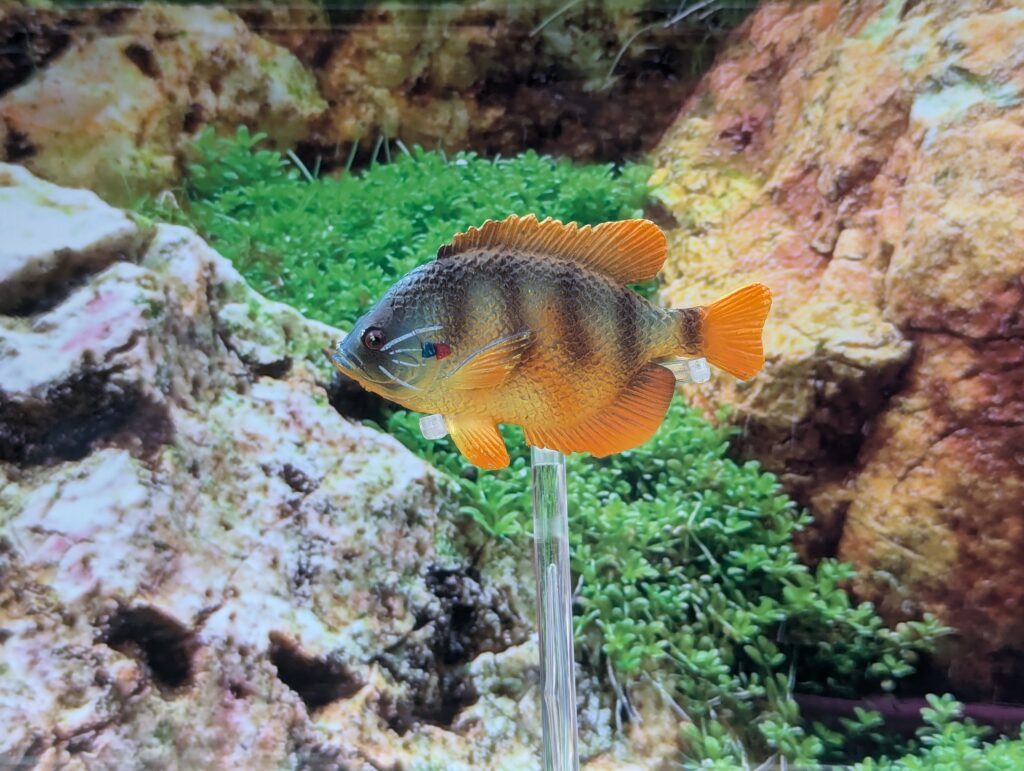
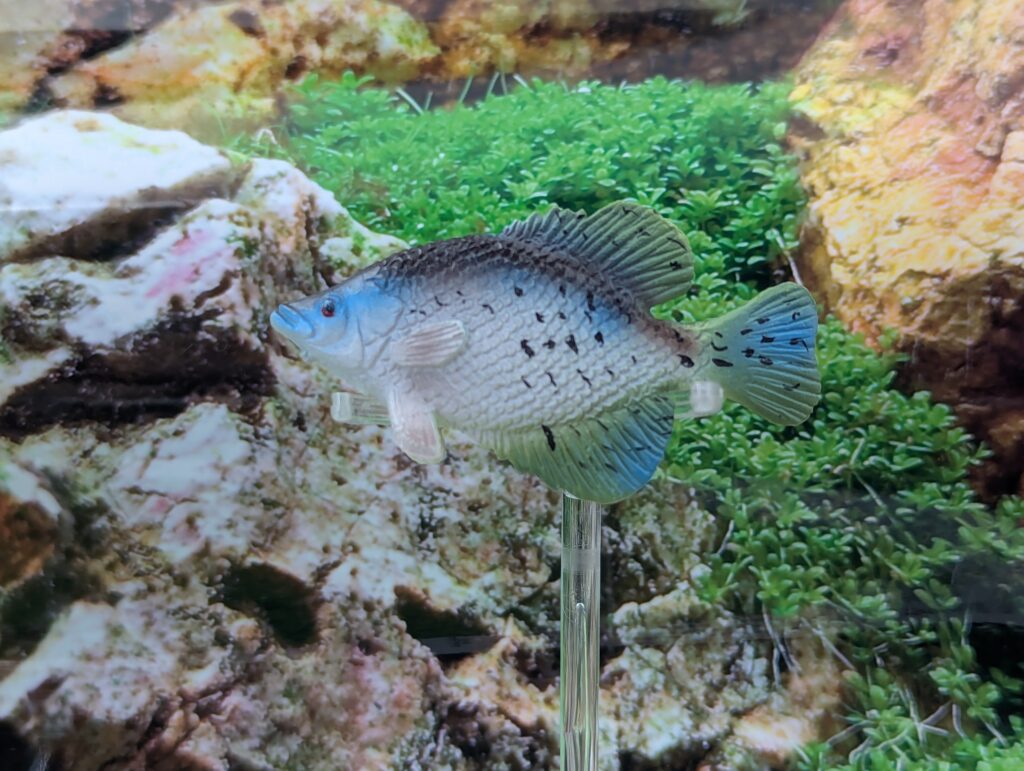
This trio includes the bluegill Lepomis macrochirus, the pumpkinseed L. gibbosus, and the crappie, Pomoxis spp. (I will go into why, at best, it might be a white crappie but I’m not certain). Overall, these are smaller species than the largemouth or smallmouth bass, but in general similar. All three are naturally found in many waterways in the eastern US and Canada, as well as being introduced in other regions for anglers. They tend to be fairly adaptable in terms of habitat and temperatures, and in the case of bluegills can tolerate higher salinity. All three are also carnivorous, taking pretty much any prey that they can catch, which might be why they make great angling targets as well. And all three are also small enough that they are commonly preyed upon by larger predatory fish like bass and pike. The three fish represented are all listed as Least Concern by the IUCN (and variously introduced/invasive in different parts of the world).
Bluegill Lepomis macrochirus
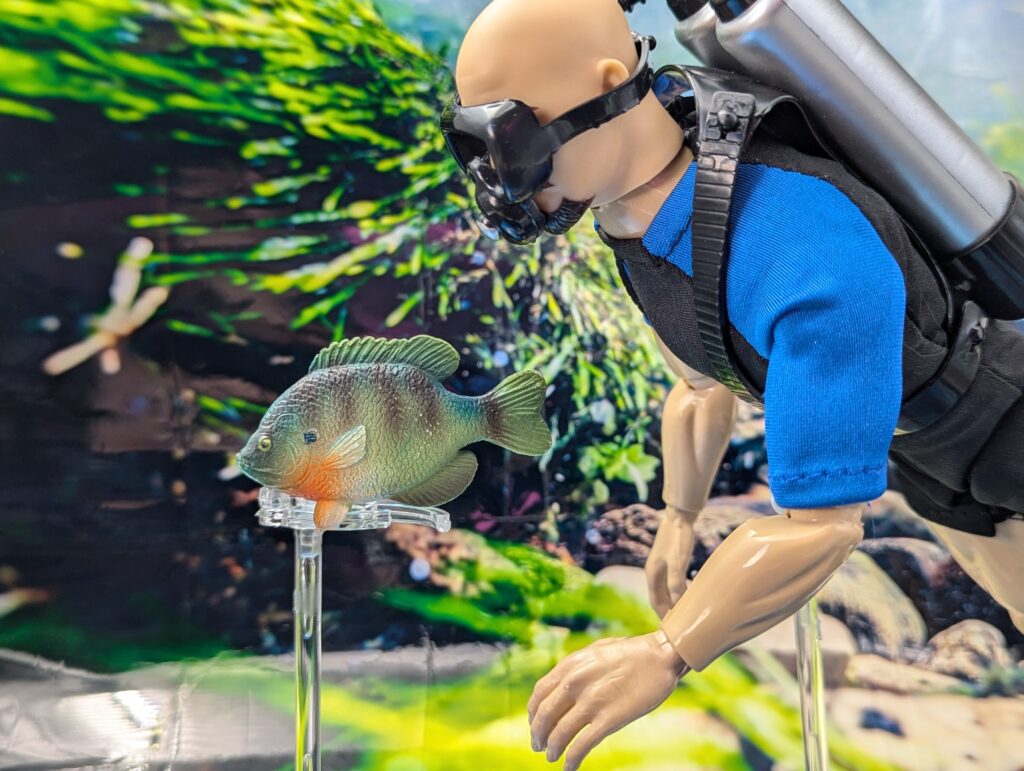
First up we have a bluegill, a very familiar species of sunfish that has been discussed on the blog previously. They are naturally found in shallows streams, ponds, creeks and other habitats from southern Ontario to northern Mexico along northern North America. They have also been released throughout much of North America as well as much of the rest of the world (including Japan of course). They’ve been discussed previously as highly adaptable predators that will eat pretty much anything but are also commonly prey in their natural locations. As mentioned in the earlier post, a very large bluegill would be 40cm (15 inches) but are more likely to be around 19cm (7.5inches) long.
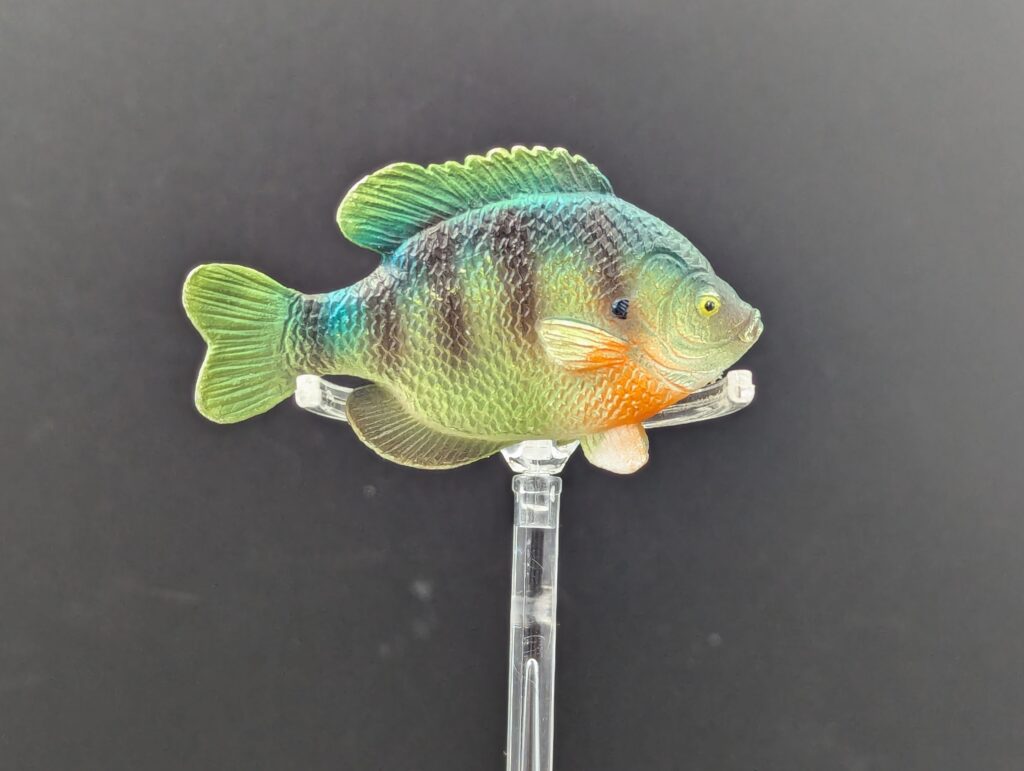
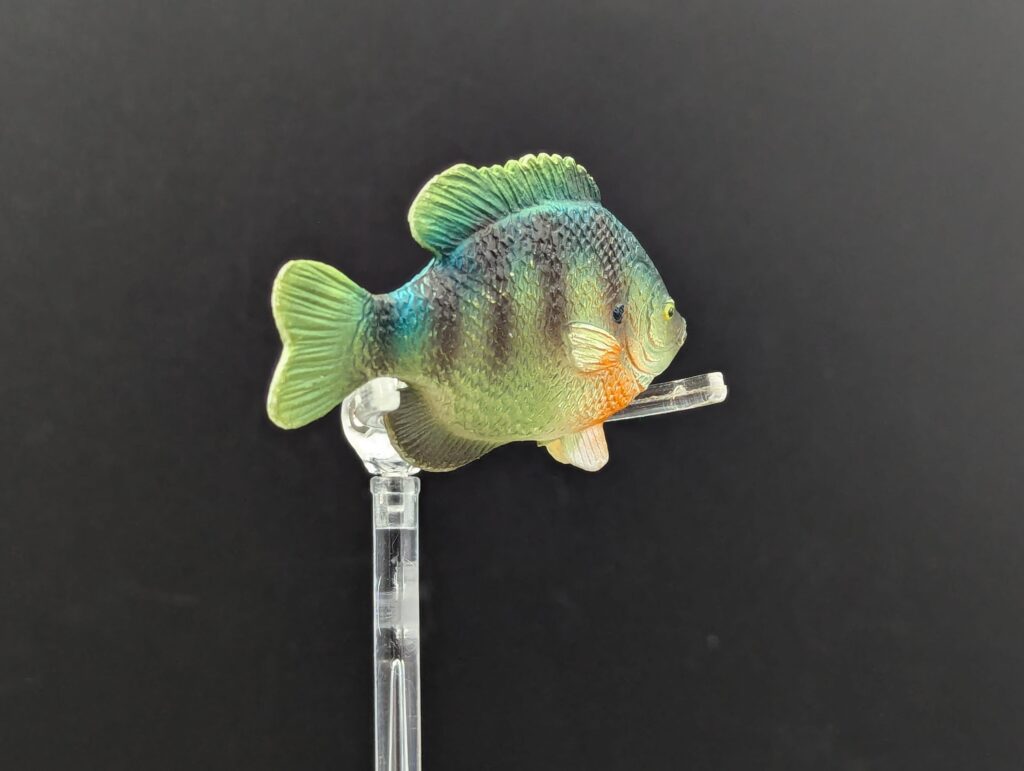
The general sculpt is pretty good, at least recognizable as a centrarchid–a very round body with a distinctly separated tail off a distinct caudal peduncle. The general shape is right, and the finnage looks good. As with many RTF figures, the pectoral fins are sculpted tight against the body, with the pelvic fins extended out to act as a ‘stand’ for the figure–as an aside, of all of the RTF figures I have, the bluegill is the worst for being unstable. The anal fin is deep and curved but is lacking the anterior spiny rays, and the dorsal has the typical spiny-ray anterior/soft-ray posterior that we typically see in sunfish (and lots of other eupercarian fish). In terms of ray count, there appear to be 12 dorsal spines, which is correct, but I think only 10 soft rays, which is low. Another feature that is characteristic is the opercula–the gills are clearly sculpted, and importantly, there is a small extension or ‘ear’ jutting off the posterior margin of the gill.
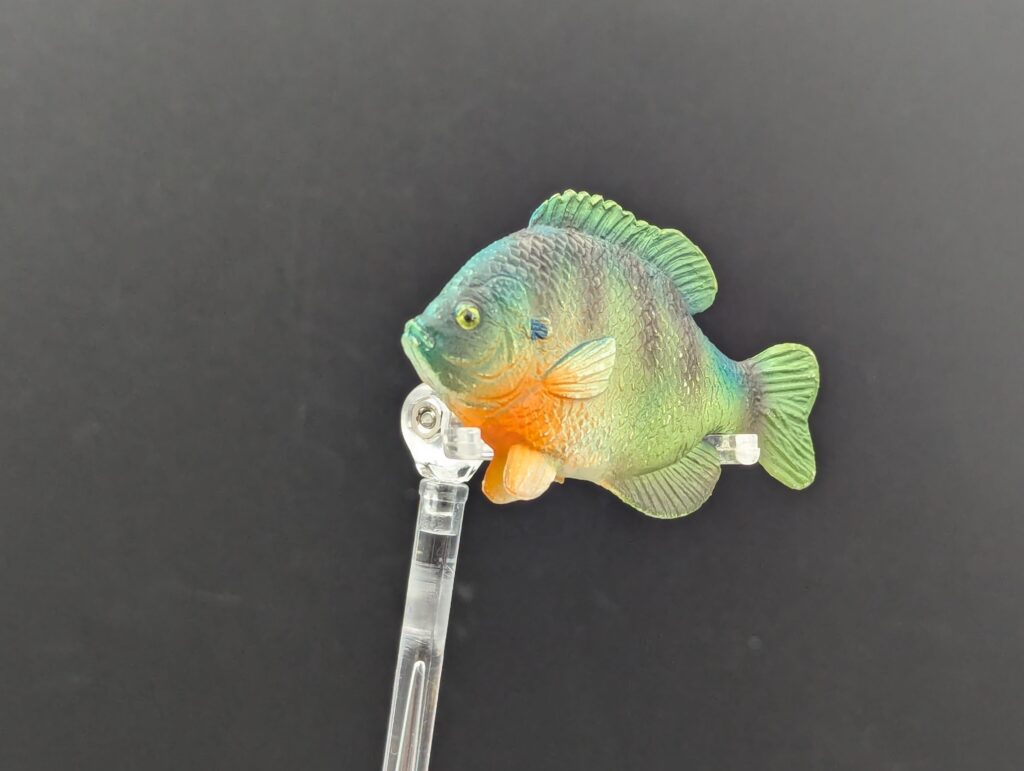
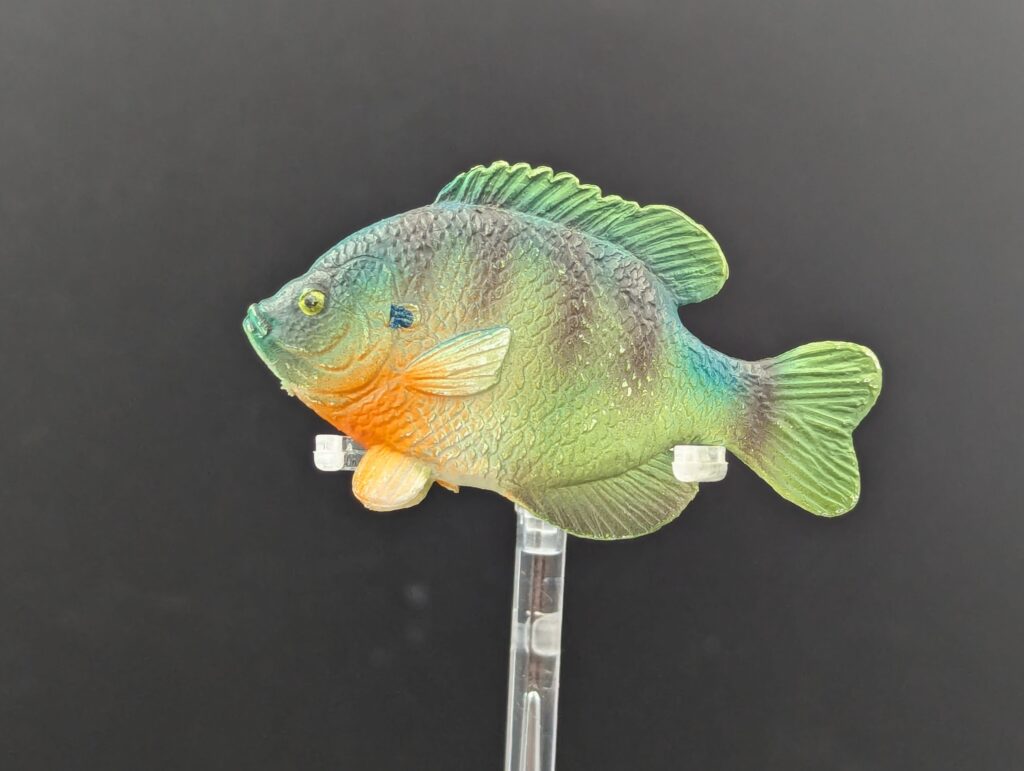
In terms of colour, it seems like a lot of care has been taken with the bluegill figure. The general colour is a light green over most of the body and fins, with only a small patch of white on the belly. The back has five distinct black bars about midway on the sides, and there is a bit of a black wash on the anal and dorsal fins. Very importantly, the figure has a bright orange over the throat–this would indicate a breeding male. The other important markings are a small patch of light blue on the upper surface of the caudal peduncle, and the dark patch on the ‘ear’ of the gill. The name ‘bluegill’ comes from a light blue colouring on the face and chin, but at best it appears there might be a little bit of a bluish wash (or it could just be the lighting). Generally a good representation of the bluegill–not a super common one, but there are at least a couple others, one from Yujin, and this is another species that was reissued with the Toy Fish Factory “American Angler” set…the only one (of four) not currently on the blog. But it’s very similar to the RTF one.
Pumpkinseed Lepomis gibbosus
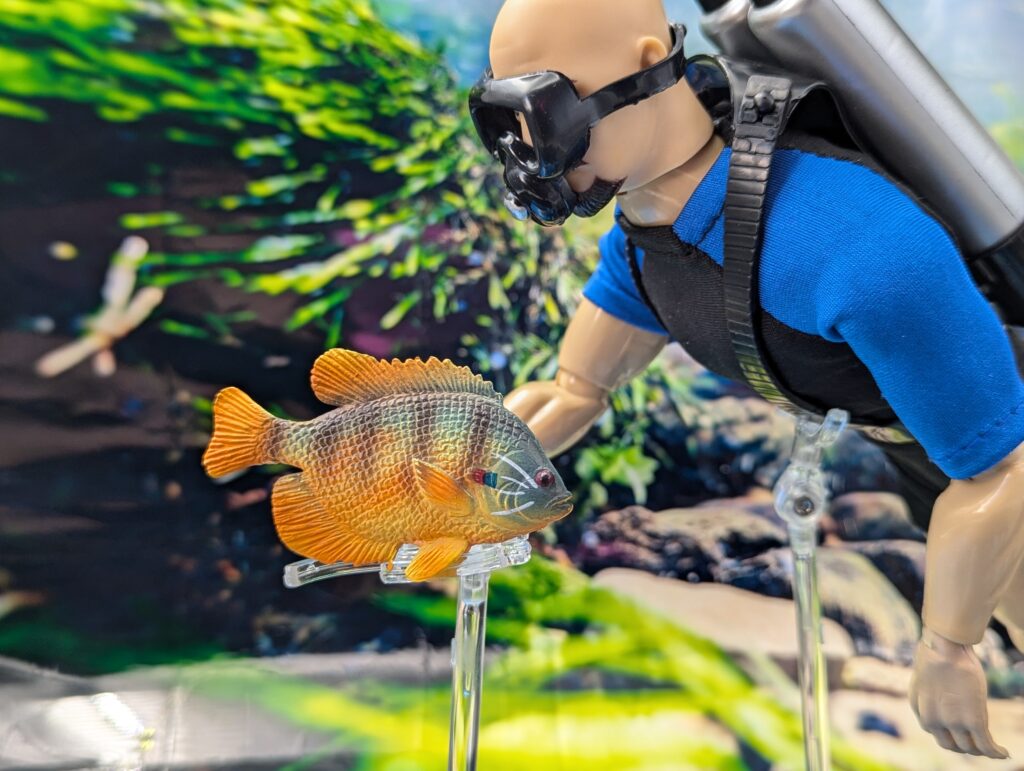
Next up we have the pumpkinseed, a close relative of the bluegill. Like the bluegill, they naturally range along the eastern side of North America, ranging from New Brunswick south to South Carolina; their range and habitat often overlaps with the larger bluegill. And also like the bluegill, pumpkinseed have been introduced all over the place, including much of North America as well as parts of Europe (where it is considered an invasive) and Europe.
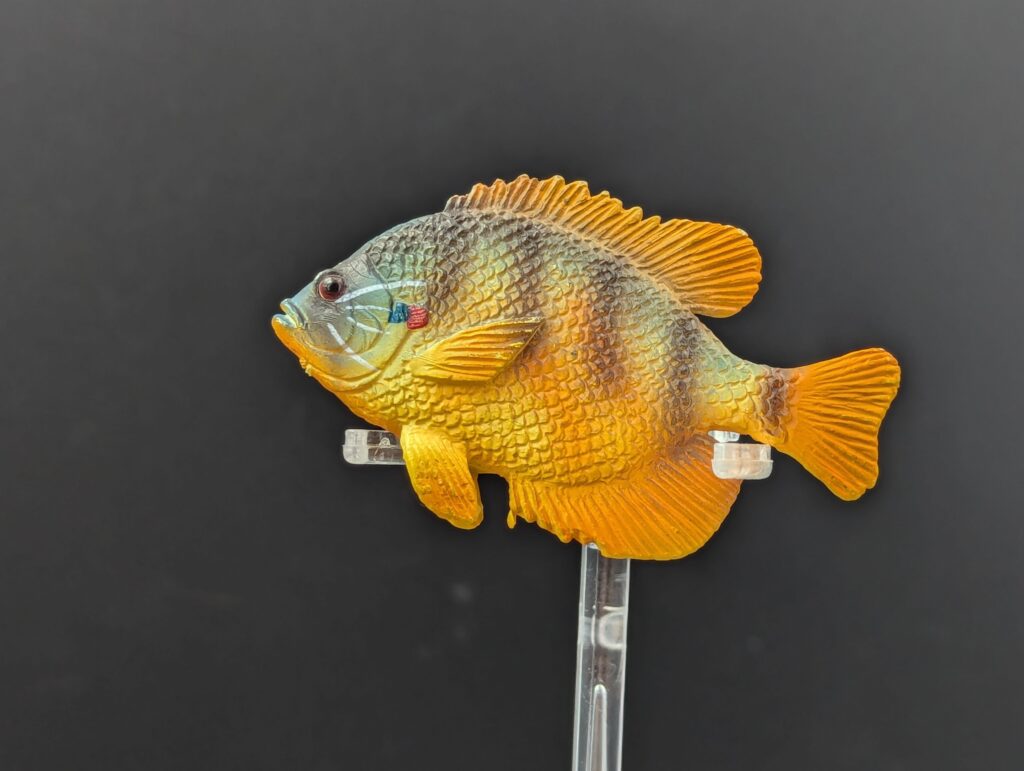
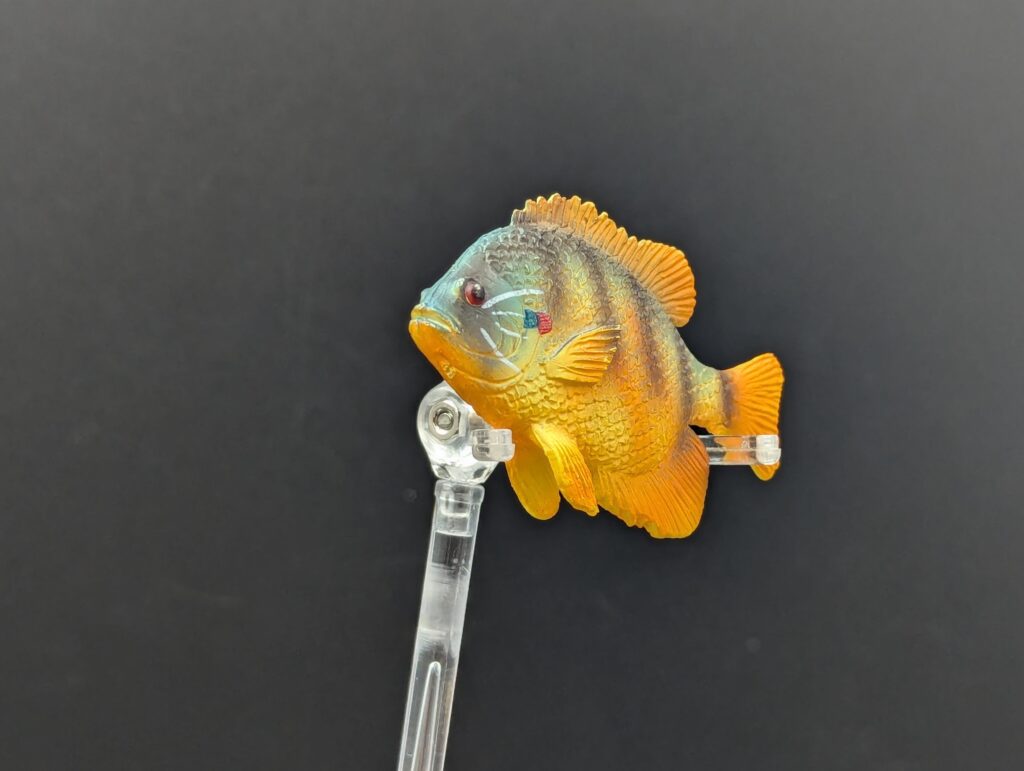
The figure is similar in shape to the bluegill but is different with close inspection. It has the same oval-ish shape, described as seed-shaped, giving it the common name. The anal fin is larger and deeper, with 6 spiny rays before a large fan of the softer rayed fin. The dorsal fin extends along the majority of the back, with a much longer fan of shorter spiny rays (I think 16) and a short , more extended fans of spiny rays. The pectoral fins are sculpted against the body, as usual, and are quite long; the pelvic fins are also quite long, and work more effectively to keep the figure upright. Also like the bluegill, the well-sculpted gill opercula have a similar ear extending backward–it extends even further back.
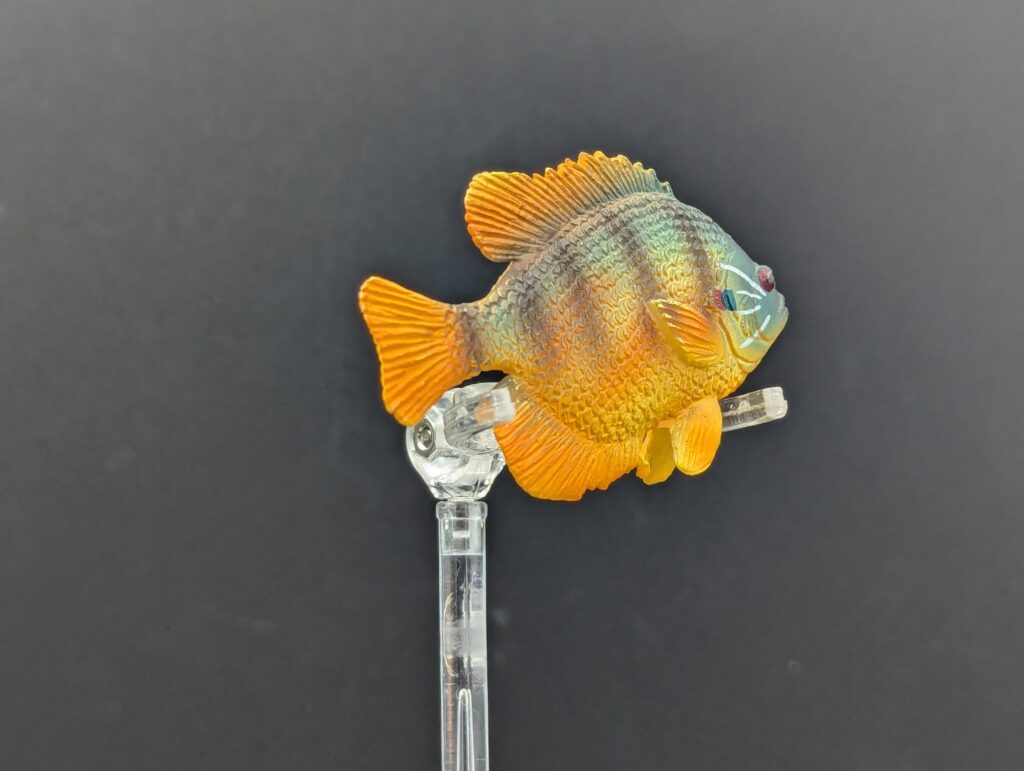
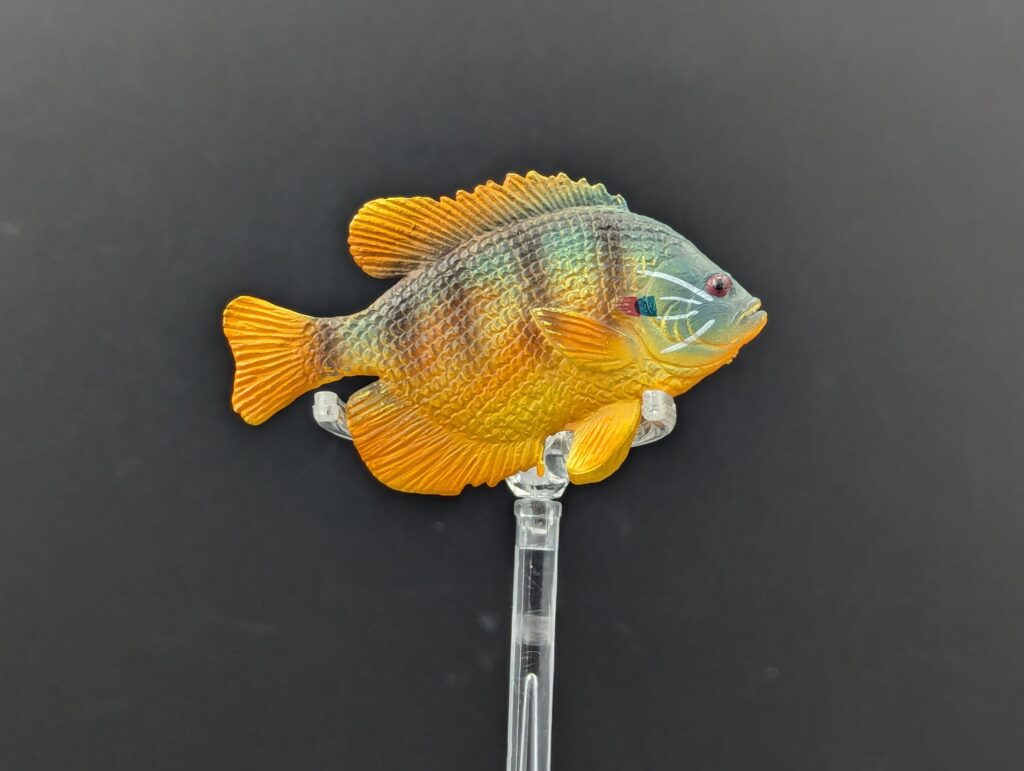
The colour on this one is easily the most complex. The back is mostly a dark greenish, while the belly, chin, fins and tail are bright orange. In the middle of the body, the orange fades in to a dark yellow onto the green. The spines on the dorsal fin should be more black, but are just the body colours. There are five dark vertical bars on the sides, some black was on the face, and four radiating white lines extending backward from the eyes over the opercula. The body should have speckles over all of it, but this is not present. The orange is also a possible colour, but probably extends further up that body than it should. The ‘ears’ of the opercula feature a red distal edge, with a bluish dot against them. This is a very characteristic feature of pumpkinseeds, so it’s good that it was included at least. In general, a nice attempt at a popular fish, and I believe the only figure of this species.
Crappie Pomoxis sp. (cf. P. annularis)
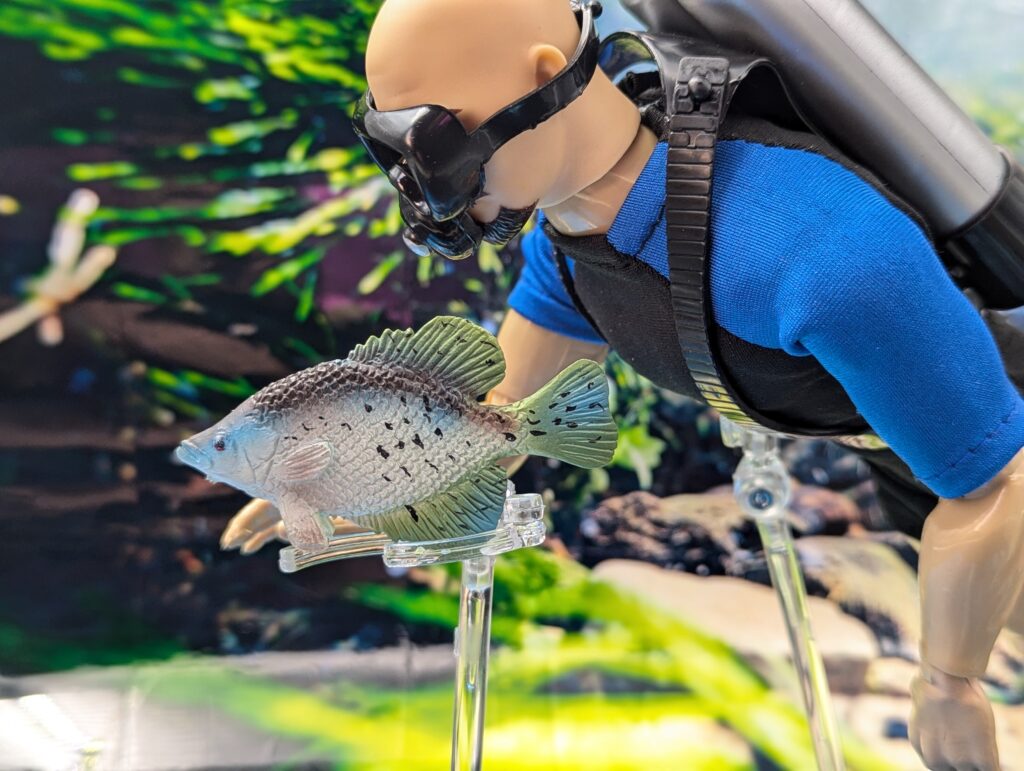
Our final figure is the crappie…genus Pomoxis…species is…indeterminate, and read on to see why there’s argument for either the black crappie (P. nigromaculatus) or the white crappie (P. annularis)–but I would lean toward the latter for a few reasons I’ll get into (hence the cf. designation). In terms of distribution and behaviour the two species are quite similar…but first, the name ‘crappie’…it’s supposed to be pronounced crop-ee, derived from the French Canadian crapet, a general word for sunfish, not a judgement (of angling or flavour, which are both apparently pretty good). Anyway, both species are naturally found in eastern North America–the white crappie is found in the Great Lakes and Mississippi basins, while the black crappie may be found a little further further north but overall they overlap (and like most popular sportfish, are introduced widely outside that range). Black crappie prefer clear waters with lots of cover, while white crappie are found in clear and turbid waters and tend to favour open water. Both are predatory, preferring small fish as adults, and both are usually 10-20cm (4 – 8 inches) although white crappie can be a little longer.
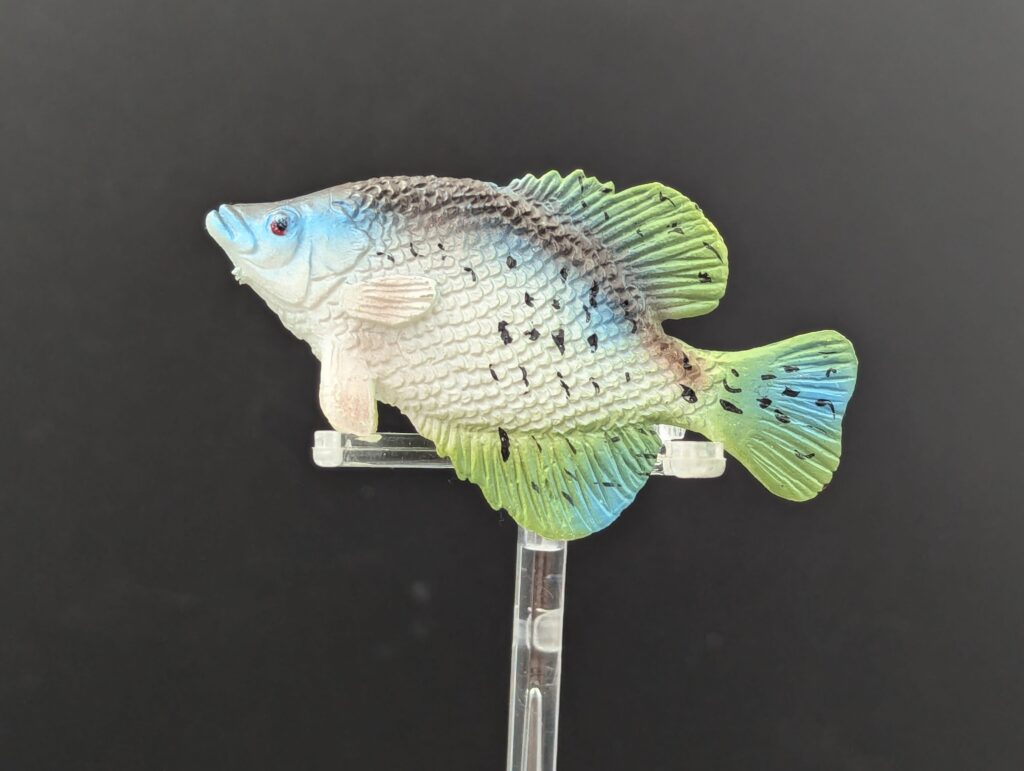
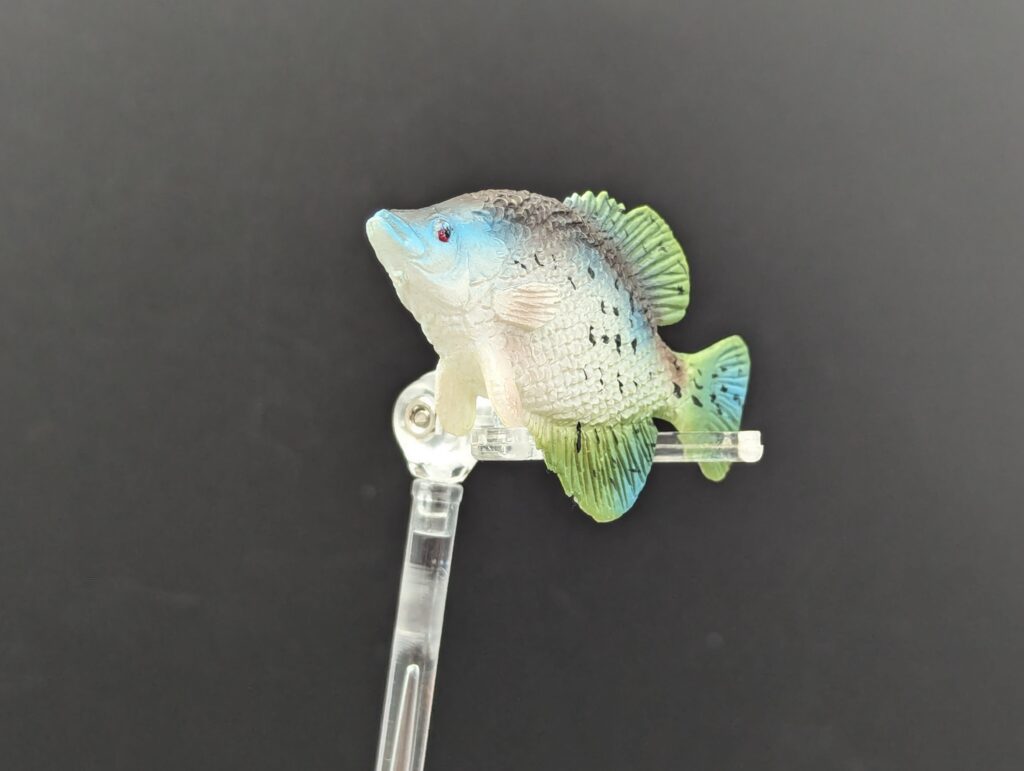
In terms of appearance…the names ‘black’ and ‘white’ are at best suggestions–both species are highly variable depending on environment–and as it turns out, the figure doesn’t do us any favours there. Black crappie tend to be completely covered in irregular black spots, whereas white crappie usually have dark vertical bars along the side. The body is otherwise greenish or silvery, with fins coloured bluish or greenish and marked with spots. As can be seen, the figure demonstrates neither of those. Instead, we have a white body with black dorsal margin, and the tail, dorsal and anal fins, face, and caudal peduncle are highlighted in green and blue. The paired fins are white. The sides and unpaired fins are also variously marked with small black spots. Trying to use colour won’t give any hints to species…white crappie would have the spots arranged in bars, while black crappie should be covered in black spots. The paint is decent, but lacks the full detail of either crappie species. But the black spots often lead some collectors to identify this as a black crappie.
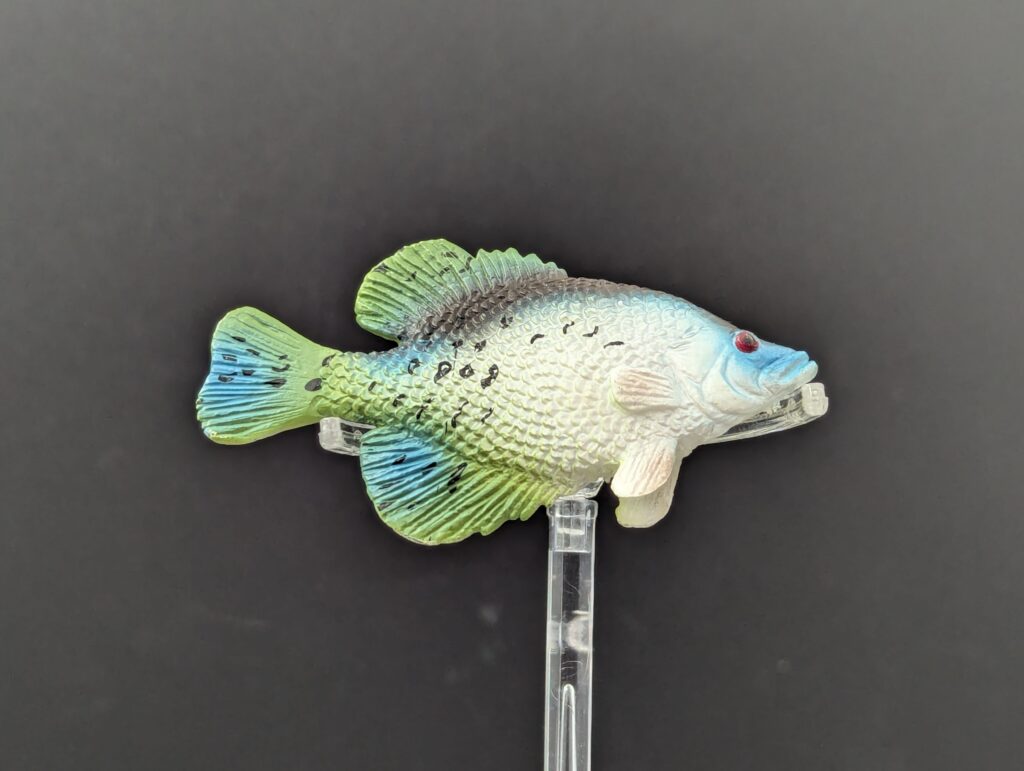
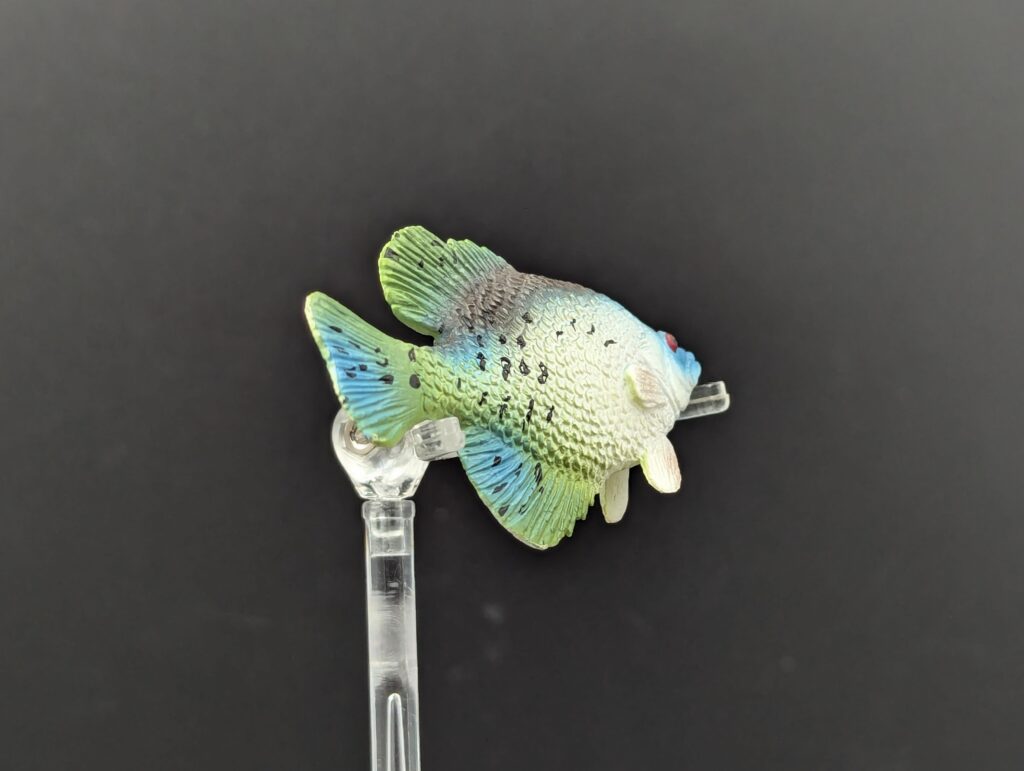
There’s a reason I’ve gone into sculpt second…it may give a better clue. The figure is about 7cm (2.75 inches) long, so the scale would range from about 1:2 to 1:3 for either species, 1:4 for a bigger white crappie. First thing of note is the body shape–the figure is more elongate than the rounded pumpkinseed or bluegill, with a long snout and upturned mouth. This is the first clue as a white crappie (black crappie are more rounded). The body is covered in obvious, heavy scales as appropriate, and the edge of the opercula are well sculpted, with a slight jagged edge–this is pretty good, as it is characteristic for Pomoxis, and gives the genus its name (it means ‘sharp cover’). The fins appear appropriate, with soft rays sculpted well, and the spiny rays on the anal and dorsal fins obviously picked out. This may be the most important feature to determine the species–it’s difficult to count, but is helpful–the anal fin has 5 but should be 6; the dorsal fin has 6, which is only true of the white crappie. Again, the fish is kind of a mix, but combined with the shape, I would be comfortable saying this is a white crappie (although it goes back and forth online). It’s an interesting figure, one that is not seen often–but of course was reissued with the Toy Fish Factory “American Angler” set as well; the sculpt is very similar to the RTF but original releases of that one had a spotless body (leading to assignations of white crappie for that one); later releases see the body covered in black spots, which is more of a black crappie thing (but the shape and spine counts are wrong).
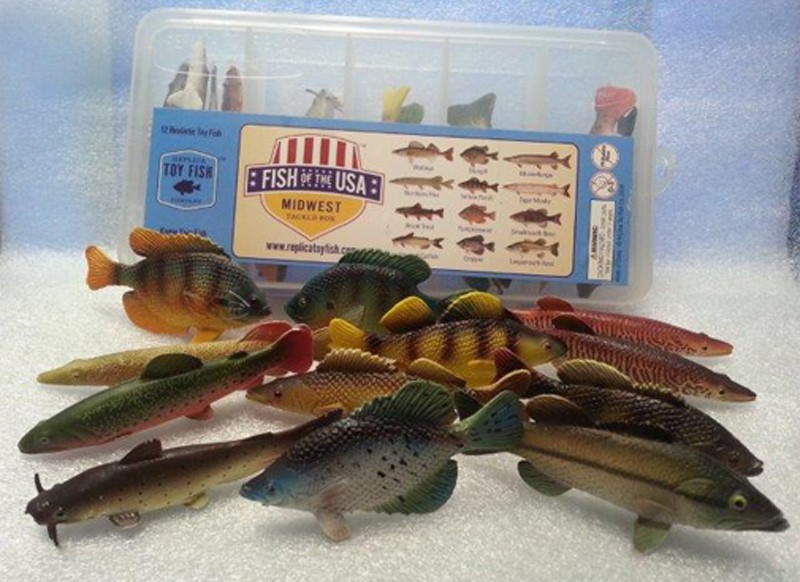
And with that, I have now covered the full run of the original Replica Toy Fish 3-inch fish figures (and half of the 6-inch as well). Overall, it was a good start for the fledgling company and demonstrated a unique ambition. I’ll often say things like “if you can get them, do so” but it’s pretty tough to do so–or to find someone to part with them! There was a lot of opportunity for these figures to try and find a hold in the toy animal market, which they were able to do for a while (I’d introduced RTF to a few different online retailers beyond my own shop!) and it’s too bad that outside forces had a negative effect on the company eventually. That said, these weren’t the end of the 3-inch fish figures, but RTF would never again release a full tackle box of figures, and never established a predictable release cycle despite some big plans (yes, I have the original list of planned 3 inch models and sets, and it’s depressing what we lost). Instead, we would see a few figures here and there, and only one more ostensible series. I will ‘tackle’ those over future posts, pun absolutely intended!
Disclaimer: links to Ebay and Amazon on the AnimalToyBlog are affiliate links, so we make a small commission if you use them. Thanks for supporting us!




The pumpkinseed coloration is way off. Pumpkinseed are spotted or checkered. Otherwise, looks great.